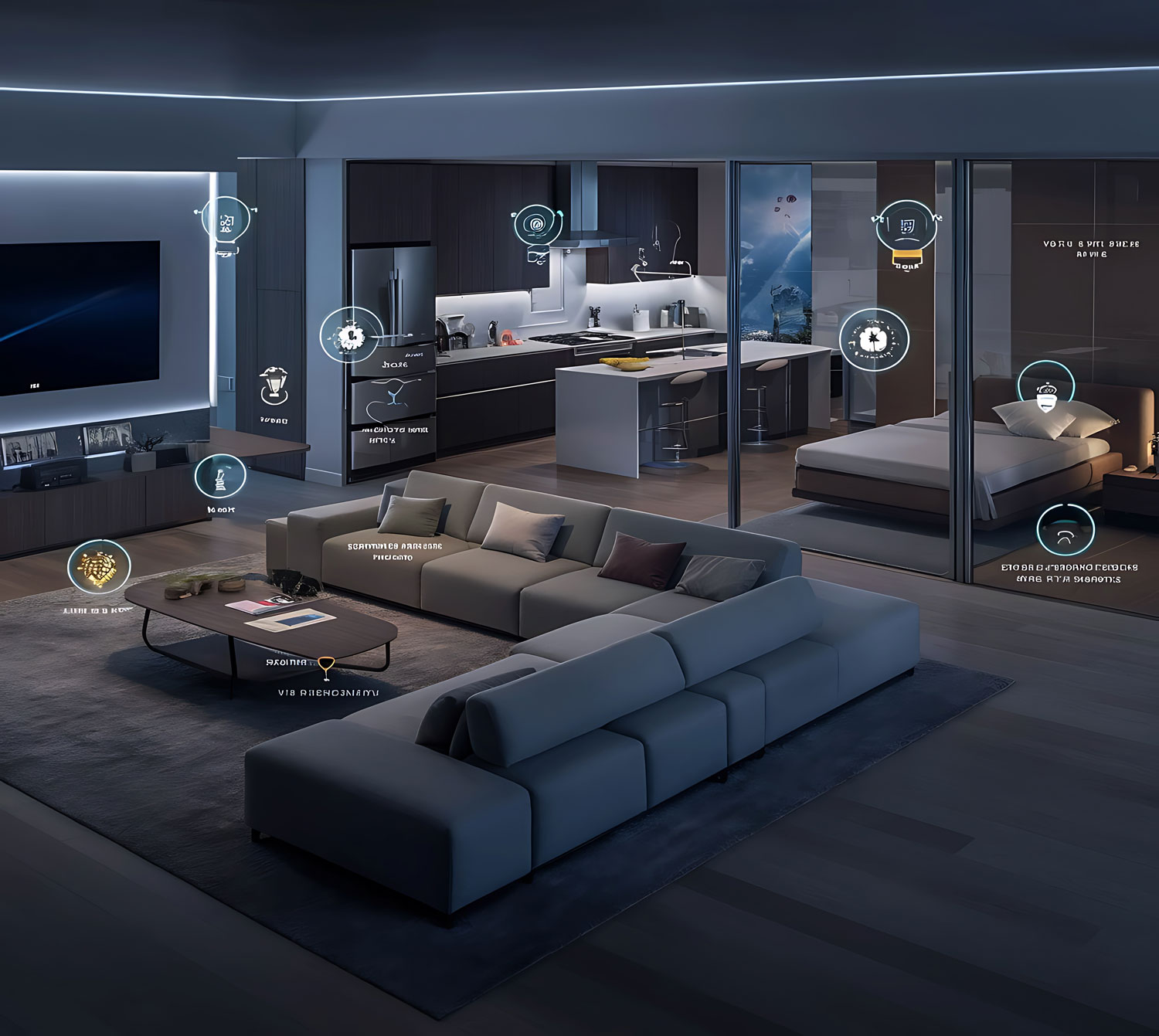What is a Smart Home Design?
A smart home is a living space where appliances and systems are interconnected through the internet, enabling users to control and automate lighting, heating, security, and entertainment from a centralized device, such as a smartphone, tablet, or voice assistant. With advancements in IoT (Internet of Things), smart homes have become a symbol of modern convenience, offering an enhanced living experience.
Benefits of a Smart Home Design
The benefits of smart home technology are multifaceted. Convenience is at the forefront, as users can control multiple systems with a single touch or voice command. Features like smart thermostats, automated lighting, and home security systems improve energy efficiency while ensuring safety and reducing costs over time. Smart homes are particularly beneficial for individuals with disabilities, enhancing accessibility through voice commands and motion-triggered devices.
Moreover, these homes are equipped with self-learning systems that adapt to residents’ preferences, such as automatically adjusting lighting or temperature based on user behavior. Whether it’s locking doors remotely or receiving real-time security updates, the integration of smart technology significantly improves the quality of life.
Key Components of a Smart Home Design
Smart Hubs and Voice Assistants
A smart hub acts as the central controller, connecting all smart devices in your home. Voice assistants like Amazon Alexa, Google Assistant, and Apple Siri allow users to manage tasks effortlessly through simple voice commands.
Smart Heating Systems
Smart heating devices, such as thermostats, automatically regulate temperature settings to optimize energy usage. Many systems include humidity or motion sensors that activate heating or cooling only when necessary, reducing energy waste and utility costs.
Smart Lighting Solutions
Modern smart lighting systems allow users to control brightness, set schedules, or automate responses to sunlight and motion. Lights can be operated remotely through a smartphone app or voice assistant, and advanced options include dimming features and customizable color settings. Automated blinds and electronic curtains further enhance energy efficiency and comfort.
Audio/Visual Systems
Home entertainment systems are now fully automated, enabling seamless connectivity between televisions, speakers, and streaming platforms. Users can control playback, schedule shows, or adjust audio settings using apps or voice commands, providing a personalized entertainment experience.
Advanced Security Systems
Smart security is a cornerstone of home automation. Features include motion-triggered cameras, live video feeds, and remote-controlled locks that notify homeowners of any unusual activity. Smart doorbells with built-in cameras allow real-time communication with visitors, enhancing safety. Many systems also include smoke detectors and carbon monoxide alarms that send emergency alerts to smartphones, offering peace of mind.
Smart Home Design Tips
Planning Your Smart Home Design
The first step in designing a smart home is identifying your needs, lifestyle, and budget. Decide on essential systems like heating, lighting, security, and entertainment, and choose devices compatible with a central hub for seamless connectivity. Ensure your home’s infrastructure, such as WiFi coverage and power supply, can support integrating multiple smart devices.
Integrating Smart Devices into Your Interior Design
Modern smart devices are sleek, minimalistic, and aesthetically pleasing, blending seamlessly into contemporary interiors. Choose devices with designs that complement your home’s style. Smart lighting solutions, for example, can be strategically placed to enhance the ambiance, while voice assistants and screens can be positioned in accessible yet unobtrusive spots.
Prioritizing User Experience
A well-designed smart home design prioritizes user-friendly interfaces and customizable automation. Features like voice command integration and intuitive mobile apps ensure that managing devices remains effortless. For maximum convenience, create automation routines tailored to daily activities, such as “Good Morning” routines that adjust lighting, temperature, and music at a set time.
Smart Home Design Trends and Innovations
AI and Machine Learning
Artificial Intelligence (AI) has transformed smart homes by enabling devices to learn user preferences and anticipate needs. From smart thermostats that adjust based on routines to fridges that recommend recipes, AI creates a highly personalized living environment.
Health Monitoring Technology
Smart home design now include features that promote health and well-being. Smart mattresses monitor sleep patterns, while air quality sensors ensure a healthier living space. For individuals with medical conditions, smart devices like medication dispensers and health monitors provide valuable assistance.
Voice and Gesture Control
For a hands-free experience, voice and gesture controls are becoming increasingly popular. Commands like “Turn off the lights” or simple gestures to lower blinds empower users to interact with their homes effortlessly. These technologies are particularly beneficial for individuals with limited mobility.
Advanced Security Solutions
Modern security systems integrate real-time monitoring, motion detection, and automated responses to keep homes safe. Whether it’s a smart lock securing your door or cameras capturing motion-triggered events, smart technology ensures round-the-clock protection.
Robotic Assistance
Robotic devices are revolutionizing household chores, from vacuum cleaners to lawnmowers. Future advancements will see robots handling complex tasks like laundry, dishwashing, and meal preparation, offering unparalleled convenience.
Troubleshooting and Maintenance
Common Smart Home Design Issues and Solutions
Connectivity problems, device malfunctions, and occasional security vulnerabilities can arise. Ensuring a strong WiFi network, performing regular software updates, and backing up device data can resolve most issues. For complex setups, professional maintenance services help optimize and troubleshoot your smart home systems.
Tips for Long-Term Maintenance
To maintain optimal performance, regularly update device firmware and software, schedule routine inspections, and back up automation settings. Keeping devices clean and checking for hardware issues will extend their lifespan and efficiency.
FAQs
What are the basic devices needed for a smart home design?
A smart home typically includes smart hubs, thermostats, lighting, security cameras, and voice assistants.
Is a smart home energy-efficient?
Yes, smart homes optimize energy usage by automating heating, lighting, and appliances, resulting in lower utility bills.
Are smart homes secure?
Smart homes offer enhanced security with real-time monitoring, remote access, and advanced alert systems. However, it’s crucial to secure devices with strong passwords and regular updates.
About Firas Engineering Consultancy
With over 27 years of expertise, Firas Engineering Consultancy specializes in innovative and sustainable designs. From private residences to large commercial projects, we bring cutting-edge solutions and creative visions to your smart home design.







